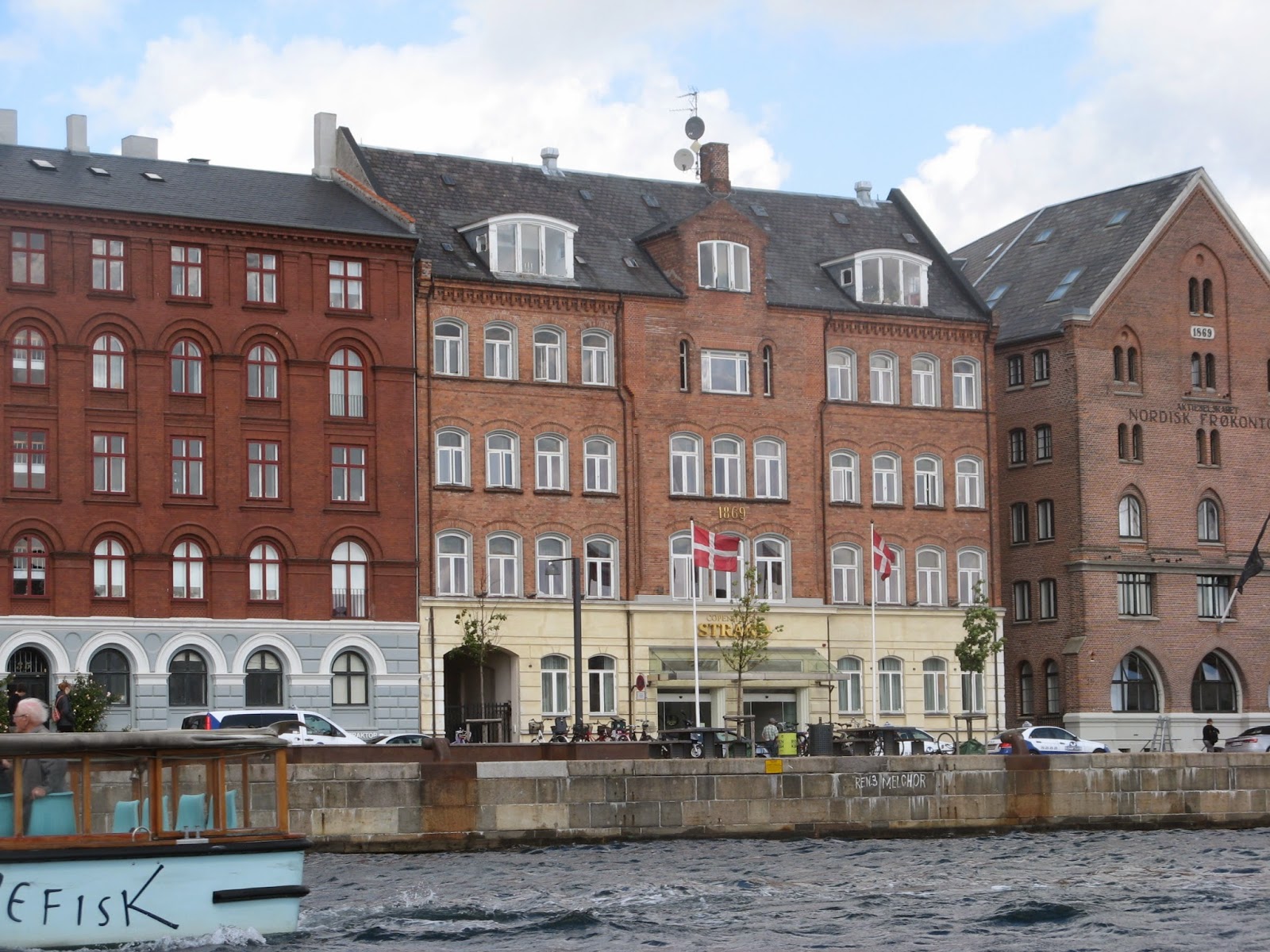 |
| The Danish Royal Opera House |
 |
| Interesting waterfront architecture. |
Danish architects have to be amongst the most innovative in the world. It was, after all, a Dane, Jorn Utzon, who designed the world renowned Sydney Opera House. I am a great fan of Danish design in all aspects from architecture and furniture to jewellery and homewares. The cruise gave us the opportunity to view some fine examples of Danish architecture, including the spectacular Royal Danish Opera House (2001), designed by Henning Larsen and The Black Diamond National Library and Museum(1999) designed by Schmidt Hammer Larsen, and so named because the sparkling water of the canal glitters on its black granite cladding.
 |
| The tower of Vor Freisers Kirke |
immaculately attired crew, we also viewed historic points of interest including the Royal Palace the unusual Vor Freisers Kirke, with it's external staircase winding around the spire, and, of course, the Little Mermaid, which was surrounded by hordes of camera toting tourists.
 |
| Spot the Little Mermaid |
 |
| Library, Christiansborg Palace |
Later in the day, and on the strong recommendation of our hotel concierge, we decided to walk to Christiania, a "free state" in the heart of Copenhagen. Just as we set off the rain came so we took refuge in Christiansborg Palace which proved to be a very happy interlude. This vast palace houses Denmark's Parliament, The Prime Minister's office, the Supreme Court and is also used as the Royal Family's reception rooms. There was something uniquely Danish about the room interiors - in the colour schemes, paintings and furnishings - a style which was new to me. Each room of the many we viewed was interesting, the dining table for 50 being particularly impressive, but the most stunning room of all was vast and hung with huge, brightly coloured, modern tapestries portraying 1000 years of history of Denmark and the world.
 |
| Tapestries at Christiansborg Palace |
The tapestries were a gift from Danish business to Queen Margarethe II for her 50th birthday but took 30 weavers 10 years to make so were finally hung on the Queen's 60th birthday Each tapestry was complex and demanded our time and attention. This was no problem to any of us including my young grandson who was totally captivated by them. We spent quite some time there, a serendipitous change of plans due to the sudden rain shower.
 |
| Detail from a Palace tapestry |
And then the sun came out so on we went towards Christiania, first visiting Vor Freisers Kirke on the way. I was very keen to climb the tower but, unfortunately, on this particular day it was closed. I think the less enthusiastic members of the family were rather pleased!
 |
| Photos are not permitted inside Christiania, for obvious reasons! |
founded in 1971 when a mixture of hippies, squatters, homeless people and anarchists stormed and took over a disused army barracks. Set on 84 acres it is now home to around 1000 people who live by their own rules, thumb their noses at Danish law and seem to be forever stuck in a 1970's time warp. It is, to say the least, a weird place. The main street is called Pusher St, which kind of gives you a clue as to what goes on there. I have never before seen mountains of hash being sold openly to all and sundry. It was interesting to note that there was a constant stream of people going in and out of the commune so it is clearly well patronised by other residents of Copenhagen. It appears that the police and local authorities turn a blind eye to this trade which is illegal under Danish law. I found Christiania to be depressing and demoralising. Groups of spaced out pot smokers were lying around on stairways and benches, some looking like very sad individuals indeed, clearly wasted on harder drugs. Christiania is said to be opposed to the trade of hard drugs but it is common knowledge that this also takes place there. It is scruffy and untidy and most of the buildings are covered in vast psychedelic murals. There is a market where stalls sell 1970s type clothing, maxi length tie dyed dresses and T shirts sporting cannabis emblems. Apparently Christiania is the 4th largest tourist attraction in the city and I can understand it, to a degree, but I couldn't get out of there fast enough and was a bit surprised by the concierge's recommendation. With two small children in tow we were concerned as to how much pot smoke they were ingesting...the air was thick with it.










.jpg)









